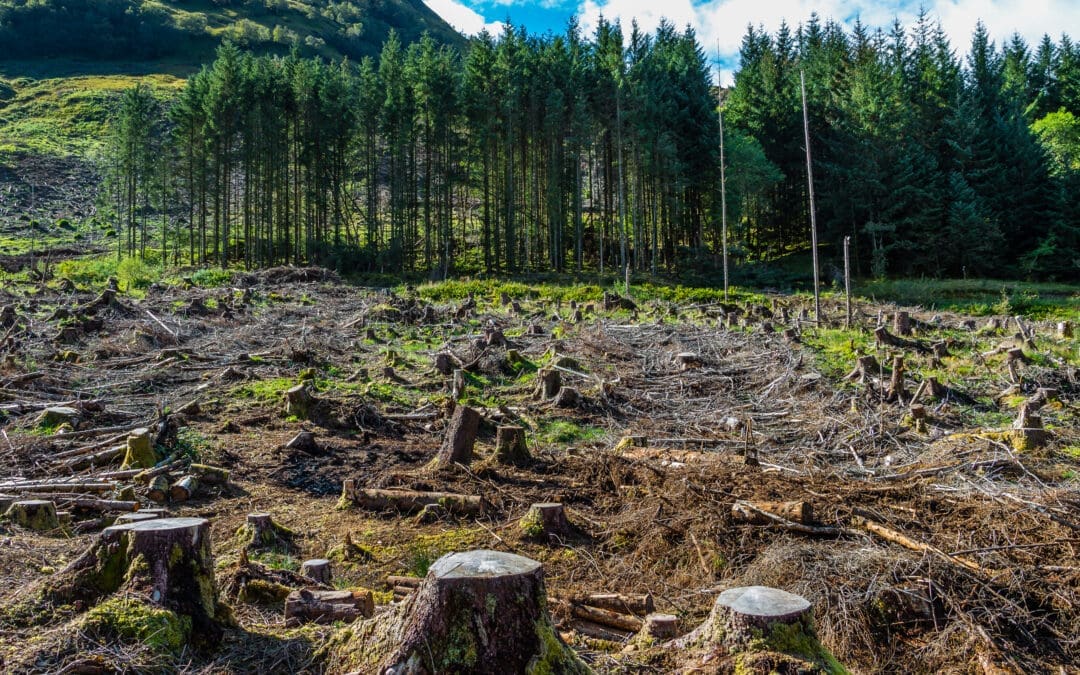Currently, companies are setting net-zero goals left, right, and center, with clean energy often synonymous with tackling emissions. Yet, impact of deforestation on net-zero progress is sometimes overlooked. By contributing to the removal of a valuable natural resource that absorbs carbon emissions, companies are slowing their own advancements. On top of that, deforestation is also a major driver of biodiversity loss, soil erosion, flooding, and a number of issues for indigenous populations. Halting and reversing deforestation holds huge, untapped potential for businesses to achieve their sustainability goals, playing their to slow the rate of climate change and then some.
Businesses, especially consumer goods companies, need to play their part. The clearing of forests for commercial agriculture (for example, the production of commodities such as palm oil or soy) is accountable for around 70% of tropical forest destruction.
Acknowledging where we are going wrong is the first step to moving in a positive direction, staying on track with climate agreements and the UN’s GHG reduction targets, and protecting our forests. This all starts in the supply chain.
Map your Supply Chain
Creating better visibility over your supply chain is the first step to any deforestation reduction efforts. To properly identify and address deforestation risk, you need the ability to trace products in your forest supply chains down to the source.
This is especially important for the issues surrounding deforestation. Smallholders often make up a significant share of a company’s supply chain for commodities, such as palm oil and soy. Knowing who and where these smallholders are is crucial for backing claims and certifications and driving improvement.
If you’re unsure how to get started on a supply chain mapping program, check out our previous article on the subject for a few tips.
Set Clear Policies
After identifying who your suppliers are and where they’re located, make sure your deforestation policies are clear and up-to-date. These policies might be your public pledge or deforestation-free commitments, or they may be internal codes of conduct for sourcing material inputs. These policies may differ based on specific commodities for example, only purchasing certified palm oil inputs.
Policies might also extend beyond public commitments and codes of conducts to impact your suppliers as well. For instance, In Indonesia, Ahold Delhaize requires palm oil suppliers to set policies barring sourcing from protected areas.
Don’t Go at It Alone
Eliminating deforestation from supply chains has proven to be harder than initially expected. If you’re not sure which policies to set or how to implement them throughout your supply chain, you’re not alone.
Look to collaboration and standardized assessment methodologies to create a smooth transition from aspiration to implementation. These will help you plan your policies both internally and with suppliers. And there’s no shortage of industry groups and certification standards you have at your fingertips to get involved with:
- Roundtable on Sustainable Palm Oil (RSPO): RSPO certification scheme is designed to standardize sustainable palm oil principles and provide smallholders access to international markets.
- Earthworm Foundation: Engagement for Policy Implementation (EPI) Palm Oil Assessment helps you track suppliers’ deforestation, peat, and exploitation policies at the mill and plantation levels.
- Rainforest Alliance: Helps you track suppliers’ deforestation policies and certification efforts in alignment with Accountability Framework Principles.
- Canopy: Ranks viscose producers and their progress towards eliminating ancient and endangered forests from their supply; helps fashion, food and beverage, and beauty brands develop more innovative, sustainable materials.
Don’t forget that you’re not trying to revolutionize the process, and that most hang-ups happen when companies attempt to reinvent the wheel. These standards and frameworks are designed to help you ask the right questions and productively engage with your suppliers.
Establish a Baseline
After implementing your internal and external policies and communicating these succinctly with your suppliers, it’s now time to harvest additional data to evaluate and create a baseline of supplier performance.
Supplier sustainability assessment is a method of choice for collecting this information. To start, try asking the following questions as you map your supply chain:
- Are you using certified supply?
- Do you have a formalized deforestation policy, and if so, could you present a copy?
- Do you verify compliance with no deforestation? If so, how?
Once you’ve gathered this information, you’re able to measure your progress towards having a deforestation-free supply chain and be able to single out which of your suppliers need some extra attention and support.
If you’re having problems collecting data from sub-tier suppliers, consider using other resources like satellite monitoring to document any changes in land use.
Also, if you’re new to sending supplier sustainability assessments, check out some of SupplyShift’s recommended best practices.
Create a Strategy for Noncompliance
You’ve sent out your assessment and identified your suppliers with a high deforestation risk (maybe they’re not using certified inputs or can’t provide a formalized deforestation policy), you need to decide how to deal with non-compliant suppliers. Do you exclude them from future contracts, or do you engage them to reform?
Naturally, some companies may have already pledged to preferentially source commodities from locations with low deforestation risks and, therefore, may choose to exclude suppliers based on their location alone. However, as of this moment, the market is gravitating towards addressing deforestation issues with a “jurisdictional approach.”
This approach ranges from efforts to help suppliers achieve greater rates of palm oil certification to bringing together buyers and suppliers to co-create deforestation goals and implementation strategies.
We recommend trying to engage your non-compliant suppliers to reform. Attempt to work with them to understand what barriers they’re facing in using certified supply and create action items for them to tackle, such as increasing certified inputs by 20% over the following year. Help them establish their own internal code of conduct, including a formalized deforestation-free sourcing policy, and go from there.
Support Your Smallholders
Smallholder suppliers often dominate forest-related supply chains, but may lack the necessary finances and resources to implement stringent sustainability policies quickly. Therefore, supporting these smallholders is paramount to success.
With all the focus on what needs to be done, it’s sometimes easy to overlook the financial obstacles in the way for your smallholders. Qualifying standards and deforestation-free certifications can be pricey. That’s why leading companies are promising to support suppliers struggling to keep up financially by ensuring they can afford the necessary ecosystem services, whether through loans or direct payments. Others may be providing technical support and community development services in place of or in addition to financial assistance to help smallholders succeed.
A localized approach is imperative for driving meaningful change on deforestation, with the participation and support of the indigenous communities and smallholders inhabiting these areas.
Considering the Bigger Picture
Businesses are well-positioned to be the driving force behind anti-deforestation efforts, including a wider array of stakeholders into their strategies. But to sustain the impact, such efforts have to be complemented by regulatory action and continued investment.
However, positive changes are being made. COP26 saw numerous international commitments to contribute to reversing forest loss by 2030, a claim backed by $19.2 billion in public and private funds. Additionally, 30 leading financial institutions boasting $8.7 trillion under management have pledged to phase out deforestation in their investee supply chains by 2025.
There’s no denying that avid interest in deforestation from the financial sector is undoubtedly there. For now, businesses can lead the way by engaging their forest-related supply chains to acknowledge responsibility in contributing to this movement’s continued success and play its part in helping to tackle the climate crisis.



